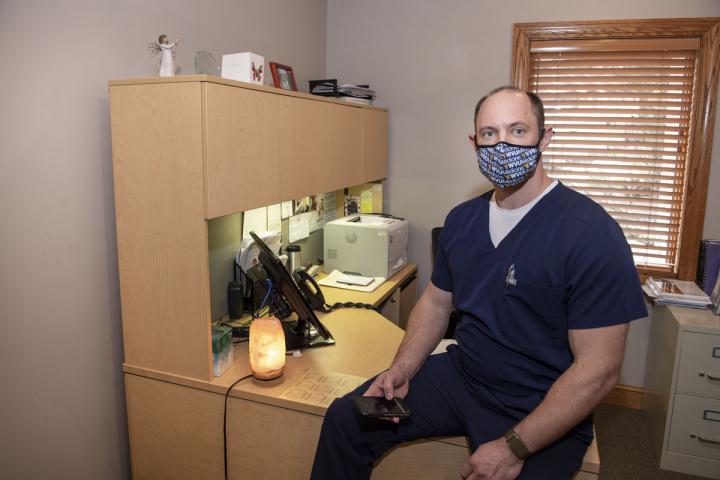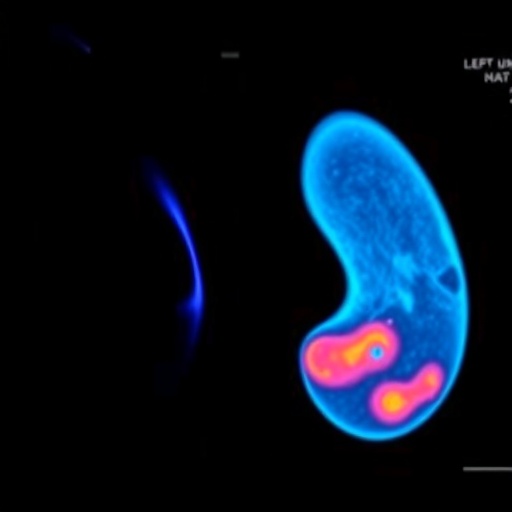
Credit: Brian Persinger/West Virginia University
If a weightlifter is pregnant, she may get conflicting medical advice about how much she can safely lift at the gym. One doctor might say she shouldn’t exceed 90 pounds. Another might draw the line at 25. Still another might suggest that she suspend her workouts entirely.
Doctors’ opinions vary widely when it comes to exercise during pregnancy because research into pregnant women’s fitness has been scarce. But with a new study, Shon Rowan–an associate professor with the West Virginia University School of Medicine–is using wearable technology to fill that knowledge gap.
“There are not many studies looking at exercise in pregnancy,” said Rowan, an infertility physician with WVU Medicine. “This is in large part due to Institutional Review Boards not wanting to approve studies due to risks. However, retrospective studies show exercise to be of great benefit to pregnant women.”
The device at the center of Rowan’s study–called WHOOP–is worn on the wrist. Sixty times each second, it collects data about the wearer’s resting heart rate, heart rate variability, respiratory rate and sleep.
WHOOP’s ability to detect heart rate variability sets it apart from other devices, such as FitBit.
To the best of the researchers’ knowledge, this study is the first to use a wearable device to monitor heart rate data prior to, through and after pregnancy.
Knowing how much someone’s heart rate varies over time can provide insight into her health.
“Say you’re sitting there with a heart rate of 60 beats a minute,” Rowan said. “Your heart is not beating exactly once every second. It may be 1.5 seconds, then 0.7 seconds, then 0.8 seconds.”
Generally speaking, the more someone’s heart rate varies, the better shape she’s in.
Pregnancy doesn’t have to mean fitness losses
The research team provided WHOOP devices to women who were trying to conceive, including patients from the WVU OB/GYN clinic and the local community.
“By enrolling women who exercise, we made the variable pregnancy as opposed to enrolling pregnant women and then adding exercise,” Rowan said.
The researchers have analyzed the data associated with 12 of the participants who have since delivered their babies.
The researchers continue to scrutinize the data. But so far, the preliminary results suggest that overall, women in the study were in better shape after giving birth than before they became pregnant.
On average, the participants’ heart rate variability declined each trimester. It shot up again, however, once they delivered their babies. And it stayed elevated throughout–and even after–the six-week postpartum period.
“Studies using WHOOP in non-pregnant users have shown heart rate variability to be a marker of fitness,” Rowan said. “Therefore, this could indicate that fitness gains occur during pregnancy. Anecdotally, this has been suggested in the past. As this data is further analyzed, we may see that physiologic markers show this to be true.”
The data also indicates that the participants’ resting heart rates worsened as their due dates neared. But after the women gave birth, their resting heart rates quickly improved.
In fact, the participants’ resting heart rates were better after they gave birth than before they got pregnant. Their resting heart rates continued to improve six weeks after delivery.
“Many female athletes are concerned about the progress or lack thereof of their fitness journey during pregnancy,” said Jenna Wallace, a WVU pediatric psychologist and member of the research team. “The data we are gathering can help obstetricians to encourage and guide their pregnant patients and also to provide peace of mind to female athletes who prioritize the well-being of their babies during this important stage of life.”
The research team also included Karen Merryman, a nurse and IVF coordinator with the Department of Obstetrics and Gynecology, and Christa Lilly, a biostatistician with the School of Public Health.
The WVU Department of Obstetrics and Gynecology funded the $25,000 project, and the West Virginia Clinical & Translational Science Institute provided statistics for the research.
“At WHOOP, we work with some of the best athletes in the world, and we’re constantly pushing the boundaries of human performance,” said Kristen Holmes, WHOOP’s vice president of performance science. “At the same time, our goal is to help people of all backgrounds monitor their health so they can understand the physiological changes in their body and see how it impacts their daily lives.”
Prevention through prediction
Although the researchers initially planned this project as a pilot study, Rowan thinks the data it generated will lead to additional research into the topic.
He notes that future studies could focus on women who are sedentary before they conceive but who take up exercise during pregnancy.
Researchers could also explore whether women’s heart rate variability or resting heart rates change a few days–or even a week–before they go into labor.
“I think it would be absolutely astounding if we were able to predict labor,” he said.
For a patient with a history of pre-term labor, such a prediction could help her doctor intervene to make a full-term birth more likely.
Keeping moms and babies alive
In 2019, one in 10 babies born in the United State was pre-term, reports the Centers for Disease Control and Prevention. That rate has risen every year since 2015. Being born early can have severe consequences. Pre-term infants are more likely to experience feeding difficulties, developmental delays and problems with hearing, vision and breathing.
As common as pre-term deliveries are in the United States, C-sections are even more prevalent. According to the CDC, 31.9% of all deliveries were by C-section in 2018. That’s one of the highest C-section rates in all developed countries.
If a woman has a C-section, not only is her post-delivery recovery longer, but her risk of infection, blood clots, postpartum hemorrhage and other complications are higher. She’s also more likely to die.
And the United States has one of the highest maternal mortality rates among developed countries: 17.3 deaths per 100,000 live births, according to the CDC.
Technologies like WHOOP have the potential to ameliorate these risk factors.
“This groundbreaking study is the first step in highlighting a massive gap in the literature around exercise prescription for pregnant woman,” Holmes said. “WHOOP data was able to show that pregnancy dramatically affects things like resting heart rate, heart rate variability and ability to recover. Not only do WHOOP insights help pregnant women understand their health throughout each trimester, it also reinforces the notion that a healthy pregnancy, when it comes to exercise, is not one size fits all.”
But what this project reveals isn’t relevant only to pregnant women and their doctors. It also relates to the babies being born. Reducing a pregnant woman’s health risks can improve the odds that her baby will be born healthy, become a healthy child and grow into a healthy adult.
For instance, if a woman is diabetic and overweight during her pregnancy, her child is more likely to be diabetic and overweight when he or she reaches adulthood.
“I give a talk on exercise in pregnancy and start by saying, ‘We are constantly looking at ways to decrease hypertension in pregnancy, gestational diabetes, C-section rates, shoulder dystocia, smoking and drug use, and I’m going to spend the next 45 minutes convincing you a preventive measure for all of this is free and available to nearly all patients,'” Rowan said. “Then I present my case for how exercise can decrease all of these conditions.”
###
Media Contact
Cassie Thomas, WVU School of Medicine
[email protected]
Original Source
https:/




